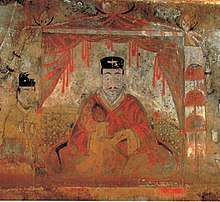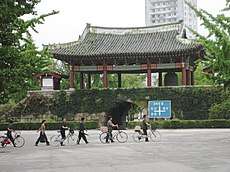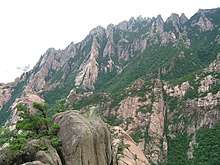Tourism in North Korea
Tourism in North Korea is tightly controlled by the North Korean government. Only about 4,000 to 6,000 Western tourists visit North Korea each year. All tourism is organized by one of several state-owned tourism bureaus, including Korea International Travel Company (KITC), Korean International Sports Travel Company (KISTC), Korean International Taekwondo Tourism Company (KITTC) and Korean International Youth Travel Company (KIYTC).[1]
Restrictions and warnings
Interactions between foreign tourists and local people have historically been tightly controlled.[2] As of January 2013, foreigners can buy SIM cards at Pyongyang airport,[3] providing access to international calling.[4]
The Swedish diplomatic mission to North Korea emphasizes that disrespect against the North Korean nation, its leaders and its symbols such as its national flag, portraits of their leaders, propaganda posters, etc. are regarded by North Korean authorities as very offensive. The tolerance level for disruptive behavior is minimal and as such can lead to imprisonment.[5]
Since 1 September 2017, the United States Department of State has prohibited the use of U.S. passports (except those with a special validation) for travel to North Korea, arguing that U.S. citizens have been subject to arrest and long-term detention for actions that would not otherwise be a cause for arrest in the United States or other countries. The U.S. Department of State also states that it has received reports of North Korean authorities detaining U.S. citizens without charges and not allowing them to depart the country.[6] North Korea has detained U.S. citizens who were part of organized tours.[7] On 1 February 2017, the United States released a travel warning to United States citizens, warning would-be visitors of previous encounters and dangers in North Korea.
World Heritage Sites
| Site | Image | Location | Criteria | Area ha (acre) |
Year | Description | Refs |
|---|---|---|---|---|---|---|---|
| Complex of Koguryo Tombs |  |
Pyongyang and Nampho, 38°51′47″N 125°24′54″E |
Cultural: (i)(ii)(iii)(iv) |
233 (580); buffer zone 1,701 (4,200) | 2004 | [8] | |
| Historic Monuments and Sites in Kaesong |  |
Kaesong, 37°58′54″N 126°30′29″E |
Cultural: (ii)(iii) |
494 (1,220); buffer zone 5,222 (12,900) | 2013 | [9] | |
- Tentative Lists
- Caves in Kujang Area (2000)
- Historical Relics in Pyongyang (2000)
- Mt. Chilbo (2000)
- Mt. Kumgang and the Relics in and around the Mountain (2000)
- Mt. Myohyang and the Relics in and around the Mountain (2000)
Guided tours
Tourists must go on guided tours. As of June 2011, the northern border to China has been opened and Chinese citizens are free to drive their own vehicles to Luo, a small North Korean northeast border region where they are free to explore, mingle, and photograph. This is seen as a first step toward expanded tourism and development in that region.
Since December 2013, North Korea has been open to tourists during the winter. The Masikryong Ski Resort outside Wonsan City in Kangwon Province opened in early 2014. While tourists have historically been restricted to Pyongyang, some tours[10] have recently been able to expand to other parts of the country such as Rajin (and the market there) and Chongjin.
Tourists can take the plane to Pyongyang from Beijing, Shenyang and Shanghai, train services to Pyongyang from Beijing and Dandong.[11]
Tourists from Western countries
For Westerners, there are a small number of private tour operators that help provide access to North Korea. These include Koryo Tours (known for its North Korean-related films such as Comrade Kim Goes Flying and strong history in the region); Uri Tours (known for its role in Dennis Rodman's and Eric Schmidt's trips to North Korea);[12] Lupine Travel (a UK-based budget travel agency known for its DPRK Amateur Golf Open);[13] Rocky Road Travel (a Berlin based company);[14] Juche Travel Services (a UK-based company);[15] and KTG (known for their small sized groups and affordable tours).[16] FarRail Tours also takes tours to see operating steam railways and the Pyongyang Metro.[17]
In 2016, an American college student, Otto Warmbier, was arrested and sentenced to 15 years' imprisonment for allegedly removing a propaganda poster from a wall in his Pyongyang hotel. At the time of his arrest, Warmbier was traveling with China-based tour operator Young Pioneer Tours (YPT) on a five-day tour of North Korea.[18] He was later released and returned to the U.S. in a coma, which led to his death on 19 June 2017.[19] As a result, YPT announced it would no longer take U.S. citizens to North Korea as the risk was "too high". Other North Korea tour companies announced they would also review their positions on accepting U.S citizens.[20] In July 2017, the U.S. government announced that American citizens would no longer be permitted to visit North Korea as tourists. The travel ban took effect on September 1, 2017.[21]
Tours from South Korea
.jpg)
In 2002, the area around Mount Kumgang, a scenic mountain close to the South Korea border, was designated as a special tourist destination: Mount Kumgang Tourist Region. Tours run by private companies brought thousands of South Koreans to Mount Kŭmgang every year[22] before the suspension of tours in late 2008 due to the shooting of a South Korean tourist.[23] When tours had not resumed by May 2010, North Korea unilaterally announced that it would seize South Korean real estate assets in the region.[24]
In July 2005, the South Korean company Hyundai Group came to an agreement with the North Korean government to open up more areas to tourism, including Baekdu Mountain and Kaesong. Kaesong was opened to daily tours for South Korean and foreign tourists in December 2007; North Korea charged US $180 for a one-day trip. The city received several hundred tourists each week, mostly South Koreans.[25]
The tours to Kaesong were suspended in December 2008 due to a political conflict between North and South Korean relating to propaganda balloons. The balloons, filled with information critical of Kim Jong-il and the North Korean regime, were sent into North Korea from just south of the border in South Korea. When South Korea did not respond to North Korean demands to stop the propaganda balloons, North Korea suspended the Kaesong tours.[26] The tours to Kaesong resumed in April 2010, but were again suspended in May 2010 following the ROKS Cheonan sinking.
Tours from China
In April 2010, the first tourist trains from Dandong, China brought visitors to North Korea for a four-day tour.[27] Before that, the international train from Beijing to Pyongyang was used as a tourist train.
In June 2011, Chinese citizens were allowed on a self-driven tour in North Korea for the first time.[28]
As of January 2013, tourists are now able to bring their own mobile phones into North Korea,[29] although without a North Korean SIM card (which became available to foreigners) the phone will not be able to make or receive calls. Previously, foreigners had to surrender their phones at the border (or airport) before entering the country.
The number of Chinese tourists visiting North Korea fell 70 percent from 2010 to 2011. One Chinese travel agency cited the limited number of packages and restrictions on where foreign tourists can travel as the main reasons for the lack of interest. Only the capital Pyongyang and Mount Kumgang are available on Chinese itineraries.[30]
Various places are accessible from the Chinese side, such as Namyang and monasteries in Chilbosan from Tumen, China. In 2011, a Tumen-Korean train service was scheduled to start.[31]
Though gambling is prohibited for North Korean citizens,[32] two casinos exist in North Korea for the Chinese tourist market – the Imperial Hotel & Casino in Rason[32] and the Pyongyang Casino in the Yanggakdo International Hotel in Pyongyang.[33]
In 2016, the North Korean government allowed Chinese tourists to stay in North Korea for a maximum of six months.[34]
Visa
.jpg)
In principle, any person is allowed to travel to North Korea; only South Koreans and journalists are routinely denied, although there have been some exceptions for journalists. For instance, Croatian journalists had special access in June 2012, although their phones were confiscated and returned as they departed and they had a special tour guide.
Travel agents can help potential visitors through the bureaucratic process. A tourist visa typically comes in the form of a blue travel paper which is stamped by North Korean customs instead of the passport. The travel paper is taken away upon exiting the country. The tourist visa can also be issued, upon request, in the form of a sticker endorsed in the visitor's passport. However this is only possible if there are any diplomatic representations of North Korea in the visitor's home country. Visitors are not allowed to travel outside designated tour areas without their Korean guides.[2]
Before 2010,[35] tourists holding United States passports were not granted visas, except during the Arirang Festival mass games.[36] U.S. citizens, journalists and citizens from other nations have also been given special permission to enter as members of the Korean Friendship Association and Choson Exchange.[37] Citizens of South Korea require special permission from both governments to enter North Korea and are typically not granted such permission for regular tourism except in special tourist areas designated for South Koreans.
Only citizens of Singapore and Malaysia were allowed to enter North Korea on normal passports without a visa, although the exemptions for both citizens were revoked in February 2017.[38][39]
See also
References
- Borowiec, Steven. "Despite warnings, more Western tourists are traveling to North Korea". latimes.com.
- Compare: McGeown, Kate (2003-09-17). "On holiday in North Korea". BBC News. Retrieved 2008-01-04.
[...] compulsory guides [...] accompany all foreign tourists [...].
- "North Korea Loosens Cell Phone Restrictions For Visiting Foreigners". The Huffington Post. Retrieved 11 June 2015.
- "3G Internet and SIM Card in North Korea: Prices, Nuts and Bolts - North Korea (DPRK) Tours and Travel". Uri Tours Inc. Retrieved 11 June 2015.
- "Reseinformation Nordkorea (travel information North Korea". Retrieved 2016-03-22. Last updated: 2016-03-15. Translated from Swedish: "Respektlöshet mot värdlandet och dess symboler, i vid bemärkelse, tas mycket illa upp. Toleransnivån för störande beteende är minimal och sådant kan leda till fängelsestraff."
- "Country Information: North Korea (Democratic People's Republic of Korea)". U.S. Department of State - Bureau of Consular Affairs. Retrieved 15 January 2018.
- "North Korea Travel Warning". The United States Department of State. Archived from the original on 2016-03-22. Retrieved 2016-03-22. Last updated: November 20, 2015
- "Complex of Koguryo Tombs". UNESCO. Retrieved 17 Aug 2011.
- "Historic Monuments and Sites in Kaesong". UNESCO. Retrieved 4 Aug 2013.
- "Pioneering North Korea Group Tour | Book North Korea Tours". www.regent-holidays.co.uk. Retrieved 2016-06-09.
- http://www.naenara.com.kp/en/tourism/inout.php?2
- "She sent Dennis Rodman to North Korea". Retrieved 11 June 2015.
- "Did golfers 'blag' their way into N Korea?". BBC News. 2016-11-04. Retrieved 2017-02-23.;
- "Rocky Road Travel - About". Rocky Road Travel. Retrieved 28 October 2019.
- Kim, Yvonne (21 June 2017). "Who Are the Agencies Behind North Korea Tourism?". Korea Exposé. Archived from the original on 27 March 2019.
- "North Korea Travel offered by KTG – budget tours to North Korea (DPRK) & North Korea Information". Retrieved 11 June 2015.
- "North Korea Steam Railways and the Pyongyang metro". Retrieved 12 March 2017.
- Ramzy, Austin (2016-01-22). "North Korea Says It's Holding U.S. Student for 'Hostile Act'". The New York Times. ISSN 0362-4331. Retrieved 2017-06-16.
- "Otto Warmbier has severe brain injury and is unresponsive, doctors say". The Guardian. 15 June 2017. Retrieved 16 June 2017.
- Maeve Shearlaw. "Tour firm used by Otto Warmbier stops taking US citizens to North Korea". The Guardian. Retrieved June 20, 2017.
- Rosenbloom, Stephanie (July 31, 2017). "That North Korea Vacation? It'll Soon Be Out of the Question for Americans". The New York Times.
- "Tourism boost to North in works". Joongang Ilbo. 2008-02-06. Retrieved 2008-09-16.
- "S Korea hopes DPRK to begin dialogue over S Korean tourist shot dead". chinaview.cn. Archived from the original on November 6, 2009. Retrieved 2009-07-12.
- "The Chosun Ilbo (English Edition): Daily News from Korea – N.Korea Seizes S.Korean Property in Mt. Kumgang". Retrieved 11 June 2015.
- Onishi, Norimitsu (2008-01-04). "Eager South Koreans Tour a Semi-Open City in the North". The New York Times. Retrieved 2008-01-04.
- "Propaganda posted in helium balloons sparks border closure from N Korea". France24 Daily. 2008-11-24. Retrieved 2009-03-22.
- Mu, Xuequan (2010-04-25). "China's first tourist train to DPRK starts 4-day tour". Xinhua.
- Nick Rowlands, Reuters.com "Chinese motorists tour North Korea" Published 15 June 2011. https://www.reuters.com/video/2011/06/15/chinese-motorists-tour-north-korea?videoId=215962520&videoChannel=1
- "Foreigners Now Permitted To Carry Mobile Phones In North Korea". Retrieved 11 June 2015.
- "Chinese Tourists to N.Korea Dwindling". The Chosunilbo. 2011-10-10. Retrieved 2011-10-09.
- "图们至朝鲜
开通旅游线 - 京华时报·京华网". Archived from the original on 24 December 2013. Retrieved 11 June 2015. - "North Korea Opening (Gasp!) a Casino". New York Times. July 31, 1999. Retrieved October 28, 2015.
- "An inside look at North Korea's luxury hotel industry". NKNews.org. August 23, 2013. Retrieved October 28, 2015.
- "North Korean Visa Requirements: the Ins and Outs of Getting In and Out". ChinaTours.com. Retrieved August 27, 2019.
- Anderson, Chris (2010-01-15). "Visit anytime! North Korea lifts restrictions on U.S. tourists". CNNGo. Archived from the original on 2010-01-18. Retrieved 2010-01-21.
- "US tourists can visit DPRK for mass games". People's Daily Online. 2005-09-23. Retrieved 2008-09-16.
- "Choson Exchange - Visit North Korea & Teach Entrepreneurs!". Choson Exchange - Visit North Korea & Teach Entrepreneurs!.
- "North Korea bans Malaysians ..." 12 March 2017.
- "Visa-free travel for North Koreans reduced following Malaysia attack". The Jakarta Post. 15 March 2017.
Further reading
- Jong Hwa Sun (2017). Understanding Korea: Tourism & Investment (PDF). Understanding Korea. 8. Translated by Mun Myong Song; Hong Chol. Pyongyang: Foreign Languages Publishing House. ISBN 978-9946-0-1560-6. Archived from the original (PDF) on 2017-08-12.
- Ouellette, Dean J. (2016). "The Tourism of North Korea in the Kim Jong-un Era: Propaganda, Profitmaking, and Possibilities for Engagement". Pacific Focus. 31 (3): 421–451. doi:10.1111/pafo.12084. ISSN 1225-4657.
- Willoughby, Robert (2014). North Korea: The Bradt Travel Guide (Third ed.). Chalfront: Bradt Travel Guides. ISBN 978-1-84162-476-1.
External links
| Wikivoyage has a travel guide for North Korea. |
| Wikimedia Commons has media related to Tourism in North Korea. |
- Inside North Korea: the ultimate package tour - Carole Cadwalladr, The Observer, 14 February 2010
- Departures episode guide Departures season 3, episode 12-13
- Traveling North Korea - North Korean travel and photography blog
- DPR Korea Tour - official website of the National Tourism Administration


.jpg)